Cleveland, Ohio
The 14 000 – strong Cleveland‘s Lithuanian community dates to the 19th century. It has created some of the most impressive Lithuanian heritage sites in America.
Lithuanian Cultural Garden of Cleveland
The most famous Lithuanian site in Cleveland is its Lithuanian garden, created in 1936. The garden is filled with ethnic symbols, nearly every detail there being symbols of Lithuanian pride.

Lithuanian Cultural Garden of Cleveland
The garden has three levels; the upper level consists of a Lithuanian flag and the fountain of duchess Birutė (legendarily a pagan priestess; built 1936) surrounded by busts of 19th century Lithuanian National Revival poets who called for Lithuania to be independent once again and romantically sought inspiration in the last era Lithuanian was truly free (the Grand Duchy era). These poets are priest Maironis (sculpture built 1961) and Vincas Kudirka (built 1938), the author of Lithuanian National Anthem.

Grand Duchess Birutė fountain in Cleveland Lithuanian Gardem

Vincas Kudirka statue in Cleveland Lithuanian garden
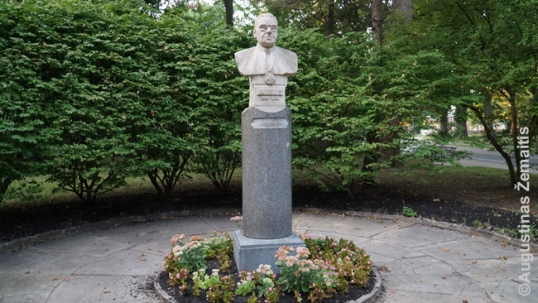
Maironis statue in Cleveland Lithuanian garden
The middle level of the garden includes massive Pillars of Gediminas, a patriotic symbol related to Grand Duke Gediminas, and a bust of Jonas Basanavičius. Known as the "Patriarch of the Nation" this scholar is frequently credited the most for the restoration of Lithuanian statehood in 1918 (bust erected 1936).
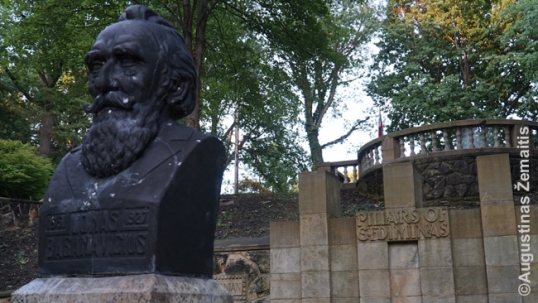
Basanavčius bust at the Lithuanian Cultural Garden, with the columns of Gediminas behind hm
The lower terrace has the garden's name, the second Lithuanian flag as well as the garden's newest addition: a Rūpintojėlis, traditional Lithuanian figure of a worried Jesus built in 1990 after Lithuania has declared independence from the Soviet Union.

Rūpintojėlis at the Lithuanian cultural gardens
The general layout of the park is also meaningful, reminding of a lyre.
Lithuanian cultural garden is one of the older cultural gardens in the city's Rockefeller Park, each of them associated with some particular nation.
The garden has been destroyed during the 1960 race riots but has been renovated by Vincas Apanius and Kęstutis Šukys afterward (they have a bench dedicated to them on the middle terrace now).
Whatever destruction happened, it was very little compared to what took place in Lithuania itself, which was occupied by the Soviet Union 1940-1990. There, nearly all patriotic monuments were demolished, including the ones that inspired the Kaunas statues of the Lithuanian Cultural Garden of Cleveland. As such, this Garden is a unique place to be "transported" back to interwar Lithuania. Interestingly, president of Lithuania Antanas Smetona said a speech here after he was forced to flee by the advancing Soviet armies in 1940.
While it is not particularly marked, some of the garden's trees have been planted by famous Lithuanian-American figures such as Anna Kaskas.
St. George Lithuanian church
The oldest Lithuanian building in Cleveland is the St. George church (1921, 6527 Superior Avenue). Towerless massive edifice has two stories with the main church prayer hall on the upper floor and a former school downstairs. In the basement, the secular parish hall was located where the local Lithuanian community met. The church once stood at the heart of the first Lithuanian district in Cleveland, surrounded by many other Lithuanian institutions and businesses.
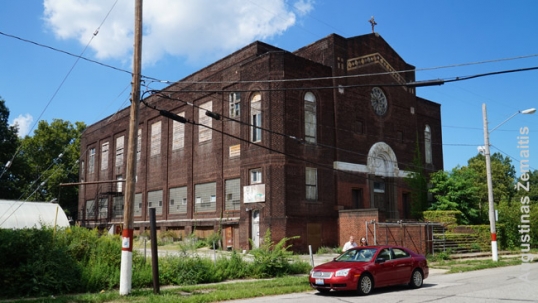
Cleveland St. George Lithuanian church
Unfortunately, there are no more meetings in the building's basement hall, no more pupils in the school's classes and the last Mass in the church itself was celebrated in 2009. Saving money, Cleveland Diocese the closed the church. At that time, it was the oldest Lithuanian parish in the USA (established 1895 when it used a smaller building).
The diocese planned to sell the building and the surrounding lot which also includes a historical 19th-century house for at least 220 000 USD, but it had to reduce the price to merely 11 000 USD. This is the reality of cities like Cleveland where the decayed urban center is unsafe since the 1966 race riots and subsequent white flight. The buildings were acquired by Community Greenhouse Partners which used the area for urban agriculture, a popular endeavor in the declining urban cores. However, apparently, even this use eventually ended, with building standing abandoned, after a brief stint as a location for Hollywood's horror film "Little Evil". While the church once had numerous Lithuanian details and memorials (Lithuanian freedom fighters, Jurgis Matulaitis), none remain inside.

Cleveland St. George Lithuanian church interior
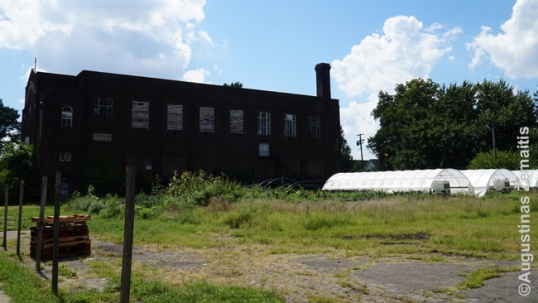
Cleveland St. George Lithuanian church with greenhouses in front
The closure of the Lithuanian church in Cleveland failed to spark protests akin to those in other communities influenced by the church-closure spree. This is because there was another Lithuanian church in Cleveland - in its northeastern part, where most of the Lithuanian life has moved out from the now-Black-majority St. George church area in the 1980s-2000s.
Many of the Lithuanian details of the St. George church have thus been moved to that new church or its warehouses, while one side-altar (without Lithuanian symbols) has been sold to an Anglican church near Seattle (Woodinville).

Image of the final mass in the St. George church. Author Antanas Jucaitis, 2009.
Not far near the St. George Lithuanian church a public artwork has been made to remind of Lithuanians and the area's other ethnic communities. For each ethnicity, there is a flag, covered by people dressed in its folk costumes and playing ethnic musical instruments. In addition to Lithuanians, the Croats, Slovenians, Ethiopians, Sudanese, Nigerians, Chinese, and Puerto Ricans are depicted (the first two ethnic groups hail from the era the district was still dominated by European immigrants and the St. George church was established). The artwork is located on St. Clair street near E. 61th street.

Public artwork reminding of ethnic communities that passed through the district
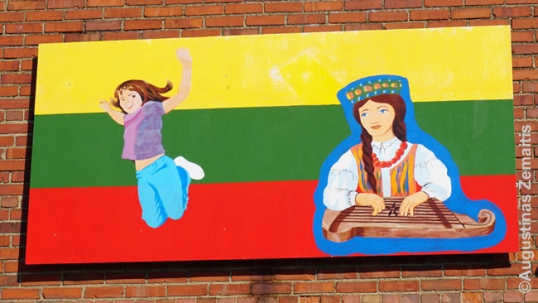
Close-up of the Lithuanian flag within the artwork, showing Lithuanian playing Kanklės
Northeast Cleveland Lithuanian church, school, and monument
Our Lady of Perpetual Help Lithuanian church (18022 Neff Rd) is part of a massive Lithuanian complex, one of the largest in America and created by some of the most famous 20th-century Lithuanian artists.

Our Lady of Pepetual Help Lithuanian church
The church itself may look rather simple and somewhat functionalist at first but, inspecting it closer, one will see many serene Lithuanian ethnic details which enhance but do not obscure the general form-inducted feeling inside that the church is like a ship of faith and Lithuanity sailing through an ocean of trouble.
Among the most prominent Lithuanian details inside are the bas-reliefs of Lithuanian cities and towns that have Virgin Mary-related cults: Žemaičių Kalvarija, Pažaislis, Vilnius, and Šiluva. Because of these bas-reliefs, the church gained a nickname of "The Shrine of Lithuanian Madonnas" (Lietuvos Madonų šventovė).

Our Lady of Perpetual Help church altar with two Madonnas bas-reliefs on the sides
The altar is also a traditional wooden Lithuanian one, featuring two towers crowned by large sun-crosses, a pagan-inspired Lithuanian version of the cross that is repeated many times, for example, on top of every column capital in the interior and on top of the church itself outside.
The Mass is celebrated there in both Lithuanian and English. The church building was constructed in 1950-1952 after the influx of some 4 000 displaced (exiled) persons from Soviet-occupied Lithuania. The architect Stasys Kudokas himself was one of those who left Lithuania due to the Soviet occupation - he would have been targeted by the Soviet regime as he had been a prominent architect of independent Lithuania. The interior was designed by a famous artist Kazys Varnelis, yet another person who left Lithuania due to the occupation. The Virgin Mary bas-reliefs were done by Ramojus Mozoliauskas, of a similar fate, in 1987, when the church interior has been modernized in the wake of Vatican II council. The altar was also installed during the 1987 renovation, created by Eduardas Kersnauskas.
Among the church's stained-glass windows, there is a one dedicated to the "Lith. Displaced persons", while the rose window is dedicated to Kudokas himself.

Dedication of a stained glass window to expelled Lithuanians
The parish itself, established 1928, is older than the Our Lady of Perpetual Help church. Beforehand, it was using a simple house as a church building. The Lithuanian displaced persons, however, continued the (re)building spree long after the church itself has been completed.
A later (1962) addition was the massive Lithuanian school, beautified by a statue of St. Casimir (the most famous Lithuanian saint) on the back facade. In the sculpture, St. Casimir is carrying famous buildings of Vilnius (the Gediminas Castle and the Cathedral). The sculpture was installed in 1984, celebrating 600 years of Christianity in Lithuania. The school operated as a parish school between 1962 and 1988 and as a Lithuanian language school until 2020.
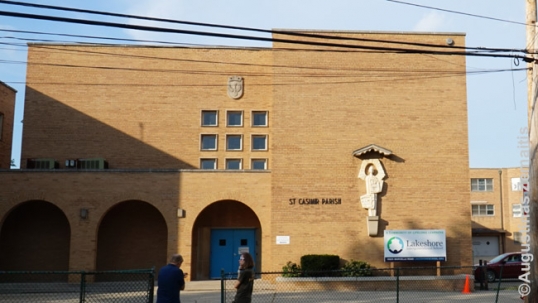
Our Lady of Perpetual Help Lithuanian school (with St. Casimir)
Next, a 1962 Lithuanian convent stands, crowned by Lithuanian cross and ethnic forms. Lithuanian St. Casimir sisters who used to live in the convent were the teachers at the parish school. Both buildings are no longer used for their original purposes, however, and have been rented out with most Lithuanian details inside removed.

Our Lady of Perpetual Help Lithuanian convent
The Lithuanian complex has been completed by the addition of the Memorial of the Centenary of Lithuanians in Cleveland on the front (designed by architect Eduardas Kersnauskas). As Lithuania was occupied by the Soviet Union at the time, the memorial also incorporated details related to the struggle for Lithuania: a Lithuanian partisan's face with a Cross of Vytis and an inscription in three languages: "Give me liberty or give me death" (English), "Dieve, Lietuvą Gink!" (Lithuanian for "God defend Lithuania"), "Redde Quod Debes" (Latin for "Give up what you must"). The composition includes a cross and Rūpintojėlis (the traditional Lithuanian symbol of a worried Jesus) that has been created by sculptor Ramojus Mozoliauskas, as well as three flagpoles, in-use during days of commemoration. Originally built in 1973, the memorial was rebuilt in 1982 and rededicated to those who died of freedom of Lithuania, according to the inscription on its back. Next to the memorial lies a stone for the deceased veterans of St. George post 613 (Lithuanian war veterans from St. George parish), originally created in 1994.

Memorial for the Centenary of Lithuanians in Cleveland

A fragment of the memorial for the Centenary of Lithuanians in Cleveland
After the merger of Our Lady of Perpetual Help Lithuanian parish and St. George Lithuanian parish into a single parish, the new united parish has been named after St. Casimir (not to be confused with the Polish St. Casimir parish of Cleveland).
Lithuanian Community Center in northeast Cleveland
Not far from the new church, a Lithuanian Community Center (877 E 185) houses a Lithuanian restaurant, bar, lounge, and party center. The center is stuffed with Lithuanian memorabilia. It also includes archives and, on the second floor, a hall that is rented out to non-Lithuanians as well and helps pay the bills.
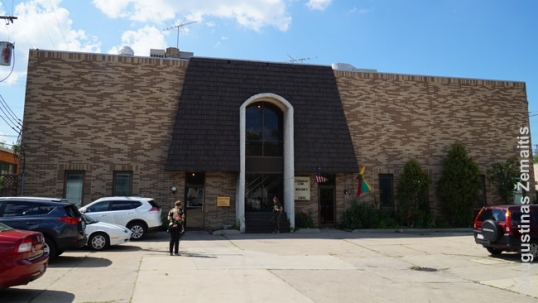
Cleveland Lithuanian club
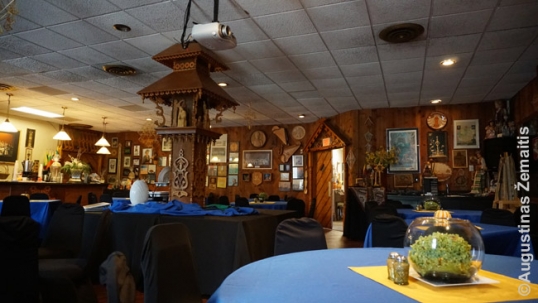
Cleveland Lithuanian club interior with lots of Lithuanian memorabilia
Like Cleveland's new Lithuanian church, the Community Center has been built in 1973 after the refugees moved in and many other Lithuanians resettled east of downtown, where the older Lithuanian club located near St. George's church had burned down.
While the community center looks quite simple from the outside, its exterior includes the stylized Vytis (Lithuanian coat of arms), a version of it that came to symbolize the Lithuanian diaspora.

Sylized Vytis on Cleveland Lithuanian club (the style often used in Lithuanian diaspora)
Antanas Smetona related sites in Cleveland
Cleveland is famous in Lithuania as the final resting place of Antanas Smetona, the first, the longest-reigning (main term 1926-1940) and arguably the most famous president of Lithuania. Because of him, the nearly entire interwar period in Lithuania is often named "Smetonic era". Among the most famous Smetona's policies was the then-unprecedented clampdown on both the Communist and Nazi movements.
The Smetonic era was an era of prosperity followed by the tragedy of World War 2 and Soviet occupation when hundreds of thousands of Lithuanians were murdered, exiled or had to flee Lithuania. Antanas Smetona himself has also fled Lithuania to the USA, where he died in a house fire in Cleveland in 1944. The House where Smetona died still stands. Currently, the district is Black majority.

The house where Antanas Smetona died
Lithuanian Americans had various opinions about Smetona at the time as some disliked him for his authoritarian rule. That is why Smetona was not allowed to live in the Lithuanian embassy in Washington (DC) which is claimed to have had anti-Smetona staff. In Cleveland, however, most of the local Lithuanians were Smetona's supporters. This was one of the reasons why Smetona chose Cleveland as a refuge. Still, the life was not easy there for Smetona: not being allowed to work legally and no longer having a support of now-occupied Lithuania, he had to rely on donations.
That is why the house Smetona lived and died at (actually, he lived in just a part of that house in the attic) is so simple.
The Grave of Antanas Smetona in the All Souls Cemetery (Chardon suburb) is even simpler. Two nearby places of interment in a massive wall inside a mausoleum are dedicated to him and to his wife. They look similar to thousands of graves of American commoners and are not somehow distinctively marked as presidential.

Mausoleum where Antanas Smetona is interred
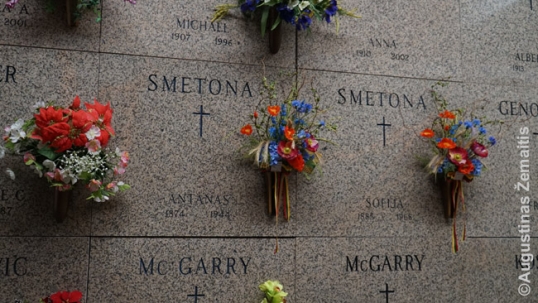
The grave of Antanas Smetona
After Lithuania restored its independence (1990) there were periodic calls to rebury the Smetonas in Lithuania. However, such calls are typically opposed by Cleveland Lithuanians for multiple reasons: the belief that Smetona's grave may be disrespected or vandalized in Lithuania by people with leftist, anti-Lithuanian, or anti-ethnic beliefs; the fact that Smetona's descendants all live in America; as well as a purported saying by Smetona himself that he would not like to ever be buried in Lithuania as even should Lithuania become independent, its culture would be too ravaged by the Soviet rule.
Telshe Yeshiva
Before World War 2, Lithuania also had a significant Jewish population, some of which have also fled the occupations to the USA. While the Jewish and ethnic Lithuanian diasporas had literally no cooperation for decades, interestingly, one of the major Lithuanian-originated Jewish institutions of the USA is also located in the same northeast part of Cleveland as most of the Lithuanian activities are (merely some 3 km away from the Lithuanian Community Center and the church).
That institution is Telshe yeshiva (Jewish religious school, 28400 Euclid Avenue), named after the Lithuanian town of Telšiai. This is a continuation of the original Telšiai yeshiva, opened in 1875 and closed after Lithuania had been occupied by the Soviet Union in 1940 (due to the Soviet atheist policies). As it happened, two of the Telšiai yeshiva's teachers were collecting donations for their yeshiva among the US Jewry at the time. Given the circumstances, they decided not to return to Lithuania but establish Telshe yeshiva in Cleveland instead. It became an important US Haredi institution; in 1960, another Telshe yeshiva was opened in Chicago.

Telshe Yeshiva entrance
Initially, the yeshiva has operated in the downtown but has acquired a farmstead in Euclid (a northeastern suburb of Cleveland) since. At its highest point, the yeshiva had some 700 students but has since declined to 170 due to a competition with many new yeshivas. It still has the buildings built for a much larger congregation of students, however. The most impressive among them is the main hall, with a library on the second floor that has thousands of old books, including some originating in Lithuania.
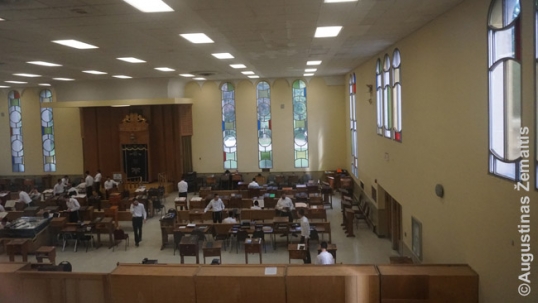
Telshe Yeshiva study hall
Other buildings include a school for children (many of whom stay in the yeshiva afterward), apartments for yeshiva students who have their families, etc. Unlike the Western education, the yeshiva education has no planned graduation: that is, many of the students remain students the whole life, analyzing Torah (Old Testament) by discussing it with fellow other students, initially directed by the more experienced ones. Most of the students never leave the yeshiva area or leave it extremely rarely (e.g. the children leave it for holidays), making yeshiva a small village-within-city.
Access to the Yeshiva may seem to be hit-or-miss for the outsiders. While "Destination Lithuanian America" volunteers were able to access the site and even be shown around by the yeshiva staff and students, some other Lithuanians and Litvaks claimed they were asked to leave. As yeshiva students have explained to us, some of them are more wary of the outsiders than the others as Euclid is not a very safe neighborhood and there have been some threats to Yeshiva as well, so a lot depends on one's own conduct and the first person one would greet.

Telshe Yeshiva students
The yeshiva still has many Litvak-originated students (and the name "Telshe" is prominently written in many places) but no longer has any ties to Lithuania itself nor are there any Lithuanian-born students among those who joined it recently. Most students have been born into Orthodox communities and the Jewish Orthodox lifestyle has all but dissipated in Lithuania itself after the Soviet atheist regime, with the majority of Jews in Lithuania become atheists.
The studies are all conducted in English while the praying is Hebrew; the Yiddish language that used to be the main language of the Litvaks is no longer used.
The map
All the Lithuanian locations, described in this article, are marked on this interactive map, made by the "Destination Lithuanian America" expedition (click the link):




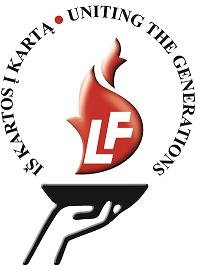

June 29th, 2014 - 11:42
Sveiki. Ieškau senai pamestą žmogų. Nežinau kur kreiptis. Bandau rašyti čia. Gal pažįstate EDAS ČEPULIS. Tėvai emigravo iš Kauno. Jam dabar gali būti apie 53 metus. Padėkite surasti. Iš anksti dėkoju už bet kokią pagalbą. Linkiu visiems geros kloteis.
June 29th, 2014 - 17:54
Sveiki,
Galite dar pabandyti parašyti šioje Facebook grupėje, ten renkasi lietuvių kilmės asmenys svetur:
https://www.facebook.com/groups/lithuanian.genealogy
August 18th, 2016 - 14:53
Ar suradot Eda?
November 19th, 2018 - 19:49
Taip, Eda gerai pazistame! Pasakykite kaip su jumis susisiekti.
September 22nd, 2014 - 15:04
My grandfather was from Lithuania. And I am looking for his history.
His name was Joseph J. Pshcouff, of Lakewood , Ohio. He worked at the Cleveland Press newspaper as a type setter 1950 to 1970.
April 18th, 2018 - 13:06
Laba diena. Ieškau pusseserės Aušros Galdikaites (mergautinė pavardė), kuri gyvena Klivlende. Jai turėtų būti 54 m. jos ieško pusseserė iš Klaipėdos Rita. Ačiū, jei galėsite padėti.
November 28th, 2018 - 23:46
My mother was raised in Cleveland. She was 100% Lithuanian. She often spoke of St. George’s Church. I know very little of her background because her father died when she was 10 years old. Her mother died when my Mother was in her 30’s. This us a great find for me. Thank you!!
April 19th, 2022 - 15:10
I enjoy your website and appreciate your extensive efforts. I’ve visited Lithuania, being 25% Lithuanian. I found it enjoyable, with pleasant rolling countryside, a good level of architectural preservation, and great history. I would like to return someday. I would even like to learn some of the language.
I also live very close to the old St George Church in Cleveland which Grandma attended.
I don’t know if you’re a native English speaker, however, some of the terminology used about the current inhabitants of the neighborhood makes it sound like you got a lot of bitter information from certain Lithuanian-Americans.
This neighborhood, while challenged was never meant to be a suburban safe space. Its realities are as much a result of who left as it is of who moved in because that’s what a city is.
I find the neighborhood mostly quiet and relatively safe. There are several cultural groups here other than the Black community including some remaining Slovenians, Puerto Ricans, and Appalachians. Old folks and school kids, only a couple teenagers who are just like I was once. It’s close to work, (downtown,) close to the Lithuanian Cultural Garden, and all the other cultural amenities of University Circle.
Sadly, the “American dream” for all groups through the 1900s was always to get a car and get the heck away from other people. Relocating to some imagined safe school system, and never leave our house and TV or computers or cars except for work. This left shops and streets abandoned, and houses in disrepair. This is even extending to the suburbs and exurbs now.
We’re beginning to see the breakdown of society as a result.
Please consider revising the resentful tone whether intended or not about members of the local Black community, the children of whom, readers might be surprised still walk to school and play in the streets and yards like all kids used to do.
April 19th, 2022 - 15:15
And for all you Cleveland Lithuanians, you’re welcome to return, build a new home or rescue an old one as I did.
St George is still standing (and as I understand can be had for a low low price) untill repairs, that is
April 22nd, 2022 - 01:11
I have edited the article somewhat now where in concerns racial relations, though I am not sure if you meant such edits.
I am not a native speaker of English language nor I have ever lived in the USA myself – I have talked and recorded stories from hundreds of Lithuanian-Americans, though. My view of the USA and Lithuanian-American communities may thus be compared somewhat to the way anthropolgists view the communities they research. It is an outsider view, which means at times it will perhaps miss something (especially something beyond the Lithuanian-American experience), however, at the other times it will possibly get something more correctly / objectively than “insiders” do, as some issues may be too much of a “sacrilege” for them to even consider; also, it may be difficult for an „outsider“ to catch the „tones of political correctness“ which are different in every country.
Also, being a Lithuanian from Lithuania, I share a similar family story to Lithuanian-Americans until our family stories diverged after their emigration.
I try to describe the fact that the population majority of the districts has changed (e.g. the former “The House where Smetona died still stands, now inhabited by Black people just like the entire district it is located at.” sentence which I now edited), as this is important for what is a research of ethnic histories of the areas (as I see all over the USA, Lithuanian churches and other institutions typically closed down where „white flight“ has happened whereas where it did not affect the particular districts, they survive, e.g. Dayton OH, Grand Rapids MI, Montreal, Hamilton, etc.). Likewise, the damage of the garden during the reacial riots is specified on the bench in the garden itself.
Maybe I do not use the correct / respectful English words, I am not sure, suggest other words if these seem to be disrespectful in describing the change in majority ethnic group.
The experiences of the Second Wave immigrants I am typically told by them are described in this article (including relating to the so-called „white flight“, etc.): http://www.truelithuania.com/lithuanian-dps-second-wave-of-emigration-1940s-10279 .
Nice to see you still live in the district. Indeed, most Cleveland Lithuanians we talked to advised us stronlgly against going there; of course, we still went. Of course, having researched Lithuanian heritage all over the world, I know safety is relative. In Sao Paulo, for example, I was told „This district is safe, we have only 3 our cars stolen here“ (in Brazilian standards that means safe). That said, for the demographic trends, it is the relative safety that matters, as the relative lack of safety (compared to other nearby dstricts) may lead to „flight“ of the inhabittants. Being from Lithuania, I also have a somewhat larger tolerance for „unsafeness“ than the suburban Americans do, even though Lithuannia is safer than the US inner cities (but Lithuania less safe than the US suburbs, e.g. you would never leave your home unlocked or things openly in your car, which some suburban Lithuanian-Americans do in their suburbs; interestingly, average murder rates in the USA and Lithuania are similar but in Lithuania they are evenly spread accross the country while in the USA disparities are huge even in the same urban areas).
December 16th, 2022 - 09:20
Can you confirm, that the full address of the house Smetona lived and died at is 11596 Ablewhite Ave, Cleveland, OH 44108, USA
December 25th, 2022 - 04:31
The exact spot is marked on this map: http://map.truelithuania.com/en/cleveland-map-of-lithuanian-sites/